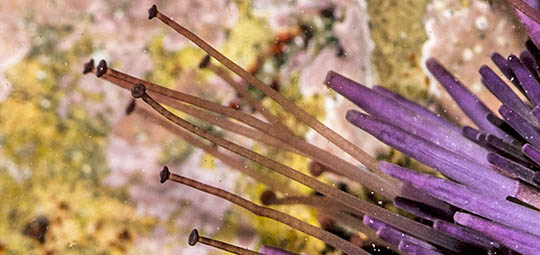Sea Urchin Tube Feet - Up Close
The tube feet that are not busy pulling the urchin along appear to be engaged in a slow dance. The feet below look a little blurry, because they were moving when the picture was taken. Notice how long and thin they are. Tube feet not only help the urchin move, they also are used to grasp food, and they are part of the respiratory or breathing system.

Watch Sea Urchin Tube Feet in Action
The tube feet are part of the urchins water vascular system. They work like a hydraulic system. The urchin contracts its muscles to push water into the tube feet. This extends the feet outwards. When the muscles relax, the feet retract.
Read more about: Sea Urchins Do Research
Bibliographic details:
- Article: Tube Feet
- Author(s): Dr. Biology
- Publisher: Arizona State University School of Life Sciences Ask A Biologist
- Site name: ASU - Ask A Biologist
- Date published:
- Date accessed:
- Link: https://askabiologist.asu.edu/tube-feet
APA Style
Dr. Biology. (). Tube Feet. ASU - Ask A Biologist. Retrieved from https://askabiologist.asu.edu/tube-feet
Chicago Manual of Style
Dr. Biology. "Tube Feet". ASU - Ask A Biologist. . https://askabiologist.asu.edu/tube-feet
Dr. Biology. "Tube Feet". ASU - Ask A Biologist. . ASU - Ask A Biologist, Web. https://askabiologist.asu.edu/tube-feet
MLA 2017 Style

Be Part of
Ask A Biologist
By volunteering, or simply sending us feedback on the site. Scientists, teachers, writers, illustrators, and translators are all important to the program. If you are interested in helping with the website we have a Volunteers page to get the process started.


